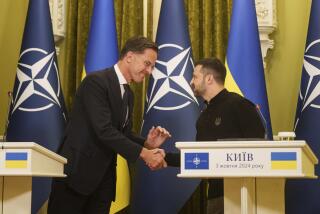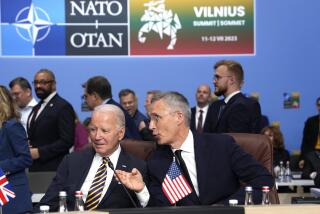Talks on Europe Troop Cuts Reopen; Hopes Rise
- Share via
VIENNA — Delegates from the North Atlantic Treaty Organization powers and the Soviet-led Warsaw Pact on Thursday began their 14th year of negotiations on military force reductions in Central Europe, and for the first time in this long stalemate, both sides are now talking cautiously about possible agreement.
“We begin a new year and a new round in a truly propitious situation, with both sides working on the basis of the same approach at the same time, and with a number of significant points on which broad agreement exists,” Dutch Ambassador Jan Hein van de Mortel told a news conference on behalf of the NATO delegation.
The Soviet Union, in a statement to the plenary session by Ambassador Valerian V. Mikhailov, was notably less negative about the new Western proposals than it had been when these were offered in early December at the end of the last round.
Mikhailov said that “for the first time we see outlines for a discussion and the contours of agreement,” although he made it clear that a major sticking point will be the problem of verifying troop reductions and the freeze on existing conventional force levels that would then follow.
No Doors Slammed
Nevertheless, in both the statement and a subsequent press briefing, the Soviet side was careful not to slam any doors and left the verification issue open to negotiation.
The NATO nations are proposing, as part of their new package, that each side should be allowed 30 automatic on-site inspections of the other’s ground forces every year, with each inspection lasting up to 60 hours, to verify that the number of troops in a given location has not been increased.
“It begins to look as if we may have a negotiation,” said one Western ambassador after the meeting.
Visit to Moscow
U.S. Ambassador Robert Blackwill did not speak at the meeting, but he had made an unusual visit to Moscow before the start of this round of the conference--known formally as the Mutual and Balanced Force Reduction talks. In an interview with a Vienna newspaper, he said he thought that the Soviet Union is prepared to make some concessions on the verification problems. If there is a flexible approach, he said, then this round of talks could well show “concrete progress.”
Meanwhile, to keep up the diplomatic initiative, the NATO powers at the plenary session handed the Warsaw Pact side a 28-page document that was described as “a framework relating to a first-phase agreement” which spells out in formal terms all of the measures that the West is now seeking.
NATO is proposing initial cuts for a three-year trial period of 11,500 Soviet troops and 5,000 U.S. troops--roughly a Soviet division and an American brigade. This would be accompanied by a freeze on any increase in military manpower on either side. Each side would then exchange detailed order-of-battle statistics down to battalion level, and the automatic on-the-spot inspections would be used to check compliance.
“Without verification, there would be a deterioration of confidence, not an enhancement of confidence,” said Van de Mortel, the Dutch ambassador.
But Soviet spokesman Nikolai Neiland accused the West of demanding “a willful increase in verification measures” and said “there must be a realistic solution and not a new source of mistrust.” However, when asked if he was rejecting or refusing the NATO proposals, he carefully said that he was giving a Soviet reaction and that it was “premature” to talk now about the terms of a verification agreement.
More to Read
Sign up for Essential California
The most important California stories and recommendations in your inbox every morning.
You may occasionally receive promotional content from the Los Angeles Times.










